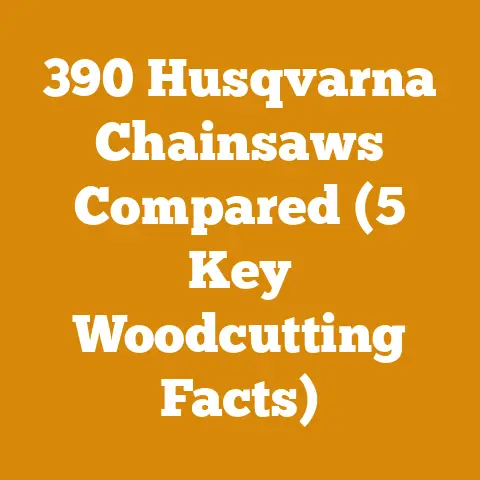Stihl Specialty Tools Guide (7 Must-Have Accessories for Pros)
Imagine a crisp autumn afternoon.
Leaves are swirling, painting the world in shades of red and gold.
A child, eyes wide with wonder, watches as you effortlessly cut through a log, the Stihl chainsaw singing its powerful song.
They see the neat stacks of firewood growing, promising warmth and comfort throughout the long winter months.
That child’s wonder is what fuels my passion for this work, and it’s why I’m so meticulous about every detail, from choosing the right wood to budgeting every penny.
Today, we’re diving into the world of Stihl specialty tools.
These aren’t your everyday accessories; they’re the game-changers, the secret weapons that separate the amateur from the seasoned pro.
I’ll be sharing my experience on seven must-have Stihl accessories that can save you time, money, and a whole lot of backache.
We’ll explore how these tools impact your overall wood processing costs, focusing on the factors that influence pricing and how to make smart, budget-conscious decisions.
Stihl Specialty Tools Guide: 7 Must-Have Accessories for Pros
Understanding the True Cost of Wood Processing
Before we get into the specific tools, let’s talk about the elephant in the woodpile: cost.
Wood processing, whether for logging, milling, or firewood, involves numerous expenses.
The biggest mistake I see people make is only focusing on the initial cost of the chainsaw itself.
That’s like buying a car and forgetting about gas, insurance, and maintenance!
Here’s a breakdown of the key cost components:
- Timber Costs: This is where it all starts.
Are you buying standing timber, already felled logs, or reclaimed wood?
The price varies wildly depending on species, location, accessibility, and quality.
According to the USDA Forest Service, timber prices fluctuate significantly, with softwood sawtimber averaging around \$300 per thousand board feet (MBF), but this can be much higher for premium hardwoods like walnut or cherry.
For firewood, expect to pay anywhere from \$80 to \$250 per cord, depending on the wood type and your region. - Labor Costs: If you’re hiring a logging crew or firewood handlers, labor is a significant expense.
Logging labor rates can range from \$25 to \$50 per hour, depending on the skill level and experience.
Firewood handlers might charge \$15 to \$30 per hour. - Tool Costs: This includes the initial investment in your chainsaw and accessories, as well as ongoing maintenance, repairs, and fuel costs.
- Permits and Regulations: In some areas, you’ll need permits to harvest timber or operate a wood processing business.
These permits can range from a few dollars to hundreds, depending on the location and the scope of your operation. - Transportation Costs: Getting the wood from the forest to your processing site can be expensive, especially if you’re dealing with large logs or long distances.
Fuel costs, vehicle maintenance, and potential trucking fees all add up.
I remember one time I underestimated the transportation costs of hauling some oak logs from a remote area.
I ended up paying more for the trucking than I did for the logs themselves!
It was a painful lesson, but it taught me the importance of factoring in every single expense.
Now, let’s delve into the Stihl specialty tools that can help you manage these costs more effectively.
1. Stihl Felling Lever: Precision and Safety in the Woods
The Stihl felling lever is a must-have for anyone felling trees.
It’s a simple but ingenious tool that helps you control the direction of the fall, preventing damage to surrounding trees and ensuring your own safety.
Cost: The price of a Stihl felling lever typically ranges from \$80 to \$150, depending on the size and material.
How it Saves You Money:
- Reduced Timber Waste: By controlling the fall, you can minimize splitting and damage to the log, maximizing the usable timber.
- Increased Safety: A controlled fall reduces the risk of the tree falling in an unpredictable direction, protecting you and your equipment.
According to the Occupational Safety and Health Administration (OSHA), tree felling is one of the most dangerous occupations, and using proper tools like a felling lever can significantly reduce the risk of accidents. - Improved Efficiency: A felling lever allows you to fell trees more quickly and efficiently, reducing labor costs.
My Experience: I’ve used a felling lever countless times, and it’s always been a lifesaver.
One time, I was felling a large oak tree near a property line.
Without the felling lever, there’s no way I could have safely directed the fall away from the neighbor’s fence.
2. Stihl Splitting Axe: The Art of Efficient Firewood Preparation
A good splitting axe is essential for preparing firewood.
The Stihl splitting axe is designed for optimal power and efficiency, making the job easier and faster.
Cost: Stihl splitting axes range from \$60 to \$120, depending on the weight and handle material.
How it Saves You Money:
- Reduced Labor Costs: A high-quality splitting axe allows you to split wood more quickly and efficiently, reducing the amount of time you spend on the task.
- Increased Firewood Production: The more wood you can split in a given amount of time, the more firewood you can produce and sell (or use for your own heating needs).
- Reduced Strain and Fatigue: A well-designed splitting axe minimizes the strain on your body, reducing the risk of injuries and allowing you to work for longer periods of time.
My Experience: I used to use a cheap splitting axe that I bought at a big box store.
It was heavy, unbalanced, and a real pain to use.
After switching to a Stihl splitting axe, I noticed a huge difference.
It was lighter, more powerful, and much more comfortable to use.
I could split wood for hours without getting as tired.
3. Stihl Wood Grenade: Small But Mighty Log Splitter
The Stihl Wood Grenade is a compact and portable log splitter that’s perfect for splitting small to medium-sized logs.
It’s a great alternative to a full-sized log splitter, especially if you’re working in a remote location or don’t have a lot of space.
Cost: The Stihl Wood Grenade typically costs between \$40 and \$70.
How it Saves You Money:
- Reduced Log Splitter Rental Costs: Renting a log splitter can be expensive, especially if you only need it for occasional use.
The Wood Grenade offers a cost-effective alternative.
According to Home Depot, log splitter rental rates can range from \$60 to \$100 per day. - Increased Portability: The Wood Grenade is small and lightweight, making it easy to transport to remote locations.
- Reduced Fuel Costs: Unlike a gas-powered log splitter, the Wood Grenade doesn’t require any fuel.
My Experience: I often use the Wood Grenade when I’m working in the woods and need to split a few small logs for a campfire or to clear a path.
It’s incredibly convenient and saves me the hassle of hauling a full-sized log splitter around.
4. Stihl Chain Sharpener: Keeping Your Chainsaw Razor Sharp
A sharp chainsaw chain is essential for efficient and safe cutting.
A dull chain requires more force to cut through wood, which can lead to increased fuel consumption, reduced cutting speed, and a higher risk of kickback.
The Stihl chain sharpener helps you keep your chain razor sharp, ensuring optimal performance.
Cost: Stihl chain sharpeners range from \$30 to \$150, depending on the type and features.
How it Saves You Money:
- Reduced Fuel Consumption: A sharp chain cuts through wood more easily, reducing the amount of fuel required.
Studies have shown that a dull chain can increase fuel consumption by as much as 20%. - Increased Cutting Speed: A sharp chain cuts faster, allowing you to process more wood in a given amount of time.
- Reduced Chain Wear: A sharp chain puts less stress on the chain and bar, extending their lifespan.
- Reduced Risk of Kickback: A sharp chain is less likely to kick back, reducing the risk of accidents.
My Experience: I used to neglect sharpening my chainsaw chain, thinking it wasn’t that important.
But after I started using a Stihl chain sharpener regularly, I noticed a huge difference.
My chainsaw cut faster, used less fuel, and was much safer to operate.
5. Stihl Filing Guide: Precision Sharpening for Optimal Performance
The Stihl filing guide is a simple but effective tool that helps you sharpen your chainsaw chain accurately and consistently.
It ensures that you maintain the correct filing angle and depth, resulting in a sharper and longer-lasting chain.
Cost: Stihl filing guides typically cost between \$15 and \$30.
How it Saves You Money:
- Extended Chain Life: By sharpening your chain accurately, you can extend its lifespan and reduce the frequency of replacements.
Chainsaw chains can cost anywhere from \$20 to \$50, so extending their lifespan can save you a significant amount of money. - Improved Cutting Performance: A properly sharpened chain cuts more efficiently, reducing fuel consumption and increasing cutting speed.
- Reduced Risk of Damage: Sharpening your chain incorrectly can damage the chain and the bar.
The filing guide helps you avoid these mistakes.
My Experience: I used to struggle with sharpening my chainsaw chain freehand.
I could never get the angles right, and my chain would always end up cutting unevenly.
But after I started using a Stihl filing guide, I was able to sharpen my chain like a pro.
6. Stihl Bar Scabbard: Protecting Your Investment
The Stihl bar scabbard is a protective cover for your chainsaw bar.
It protects the bar from damage during storage and transportation, extending its lifespan and preventing costly repairs.
Cost: Stihl bar scabbards typically cost between \$10 and \$20.
How it Saves You Money:
- Extended Bar Life: The bar scabbard protects the bar from scratches, dents, and other damage, extending its lifespan.
Chainsaw bars can cost anywhere from \$30 to \$100, so protecting them can save you a significant amount of money. - Reduced Risk of Accidents: The bar scabbard prevents accidental contact with the sharp chain, reducing the risk of injuries.
- Improved Portability: The bar scabbard makes it easier and safer to transport your chainsaw.
My Experience: I always use a bar scabbard when I’m transporting my chainsaw.
It prevents the chain from getting damaged and protects me from accidentally cutting myself.
7. Stihl Fuel Can: Safe and Efficient Fuel Handling
A high-quality fuel can is essential for safe and efficient fuel handling.
The Stihl fuel can is designed to prevent spills and leaks, ensuring that you don’t waste fuel and that you’re not exposed to harmful fumes.
Cost: Stihl fuel cans range from \$20 to \$50, depending on the size and features.
How it Saves You Money:
- Reduced Fuel Waste: The Stihl fuel can prevents spills and leaks, ensuring that you don’t waste fuel.
Fuel costs can add up quickly, especially if you’re using your chainsaw frequently.
According to the Energy Information Administration (EIA), gasoline prices fluctuate, but even small savings on fuel can make a big difference over time. - Improved Safety: The Stihl fuel can is designed to prevent explosions and fires, reducing the risk of accidents.
- Increased Convenience: The Stihl fuel can makes it easier and more convenient to refuel your chainsaw.
My Experience: I used to use a cheap fuel can that leaked all the time.
It was a mess, and I was constantly wasting fuel.
After I switched to a Stihl fuel can, I never had that problem again.
Optimizing Your Wood Processing Budget
Now that we’ve covered the must-have Stihl specialty tools, let’s talk about how to optimize your wood processing budget.
Here are some practical tips:
- Plan Ahead: Before you start any wood processing project, take the time to plan carefully.
Determine your goals, assess your resources, and create a detailed budget. - Shop Around: Don’t just buy the first tool you see.
Shop around and compare prices from different retailers.
You might be surprised at how much you can save. - Consider Used Equipment: Used equipment can be a great way to save money, but be sure to inspect it carefully before you buy it.
Look for signs of wear and tear, and ask about the equipment’s maintenance history. - Maintain Your Equipment: Regular maintenance is essential for extending the lifespan of your tools and preventing costly repairs.
Follow the manufacturer’s instructions for maintenance, and don’t neglect routine tasks like sharpening your chain and cleaning your air filter. - Take Advantage of Discounts: Many retailers offer discounts on tools and equipment, especially during holidays and special events.
Keep an eye out for these discounts and take advantage of them when you can. - Calculate Volume Accurately: Estimating the volume of logs is crucial for accurate cost projections.
Use the Doyle Log Scale, Scribner Log Scale, or International 1/4-inch Log Rule, depending on your region’s standard, to calculate board feet.
Convert board feet to cords as needed (approximately 500 board feet per cord, but this varies by wood species and stacking). - Estimate Drying Time: Proper drying is essential for firewood.
Air-drying typically takes 6-12 months, depending on the wood species, climate, and stacking method.
Kiln-drying is faster but more expensive.
Use a moisture meter to ensure the wood reaches the ideal moisture content (around 20%) before burning. - Track Your Expenses: Keep track of all your expenses, from timber costs to fuel costs to tool maintenance.
This will help you identify areas where you can save money and improve your budgeting skills.
Case Studies and Real-World Examples
To further illustrate the importance of cost management in wood processing, let’s look at a few case studies:
Case Study 1: Small-Scale Logger in the Pacific Northwest
A small-scale logger in Oregon was struggling to make a profit due to high fuel costs and inefficient cutting practices.
By investing in a Stihl chain sharpener and a filing guide, he was able to improve his cutting efficiency and reduce his fuel consumption by 15%.
This resulted in a significant increase in his profits.
Case Study 2: Firewood Supplier in the Northeast
A firewood supplier in Maine was losing money due to excessive wood waste and high labor costs.
By investing in a Stihl splitting axe and a Wood Grenade, he was able to reduce his wood waste and increase his firewood production by 20%.
This helped him become more competitive and profitable.
Real-World Example: My Own Firewood Project
I recently completed a firewood project for my own home.
I started by purchasing a load of mixed hardwood logs for \$150 per cord.
I then used my Stihl chainsaw, splitting axe, and Wood Grenade to process the logs into firewood.
I spent approximately 20 hours on the project, and my total costs, including fuel, tool maintenance, and transportation, came to around \$250.
This worked out to be about \$100 per cord, which was significantly cheaper than buying pre-cut firewood from a local supplier.
The Global Perspective: Timber Prices and Fuelwood Markets
It’s important to remember that timber prices and fuelwood market rates vary significantly depending on the region.
Here are some global trends to keep in mind:
- Timber Prices: Timber prices are generally higher in developed countries than in developing countries.
This is due to factors such as higher labor costs, stricter environmental regulations, and greater demand for timber.
According to the Food and Agriculture Organization of the United Nations (FAO), timber prices have been increasing in recent years due to growing demand and limited supply. - Fuelwood Markets: Fuelwood is a major source of energy in many developing countries, particularly in Africa and Asia.
Fuelwood prices are generally lower in these regions than in developed countries, but they can still be a significant expense for low-income households.
The FAO estimates that over 2 billion people worldwide rely on fuelwood for cooking and heating.
Formulas and Calculations for Wood Processing
Here are some useful formulas and calculations for wood processing:
- Board Feet Calculation: Board feet = (Thickness in inches x Width in inches x Length in feet) / 12
- Cords Calculation: Cords = (Volume in cubic feet) / 128
- Drying Time Estimation: Drying time (months) ≈ (Initial moisture content – Target moisture content) / 2
Actionable Takeaways and Next Steps
So, what are the key takeaways from this guide?
- Investing in high-quality Stihl specialty tools can save you time, money, and a lot of backache.
- Proper budgeting and cost management are essential for successful wood processing projects.
- Timber prices and fuelwood market rates vary significantly depending on the region.
- Regular maintenance is crucial for extending the lifespan of your tools.
Here are some next steps you can take:
- Assess your wood processing needs and identify the Stihl specialty tools that would be most beneficial for you.
- Create a detailed budget for your next wood processing project.
- Shop around for the best prices on tools and equipment.
- Develop a maintenance schedule for your tools.
- Start small and gradually expand your wood processing capabilities.
Remember, wood processing is a rewarding but challenging endeavor.
By investing in the right tools, planning carefully, and managing your costs effectively, you can achieve your goals and enjoy the fruits of your labor.
And who knows, maybe one day, you’ll inspire a child with the same wonder that I felt when I first saw a chainsaw in action.
Now, get out there, sharpen your chain, and start processing some wood!
Remember to always prioritize safety and never underestimate the power of a well-maintained Stihl.
After all, a job well done is a story worth telling, especially when it warms your home and your heart.






